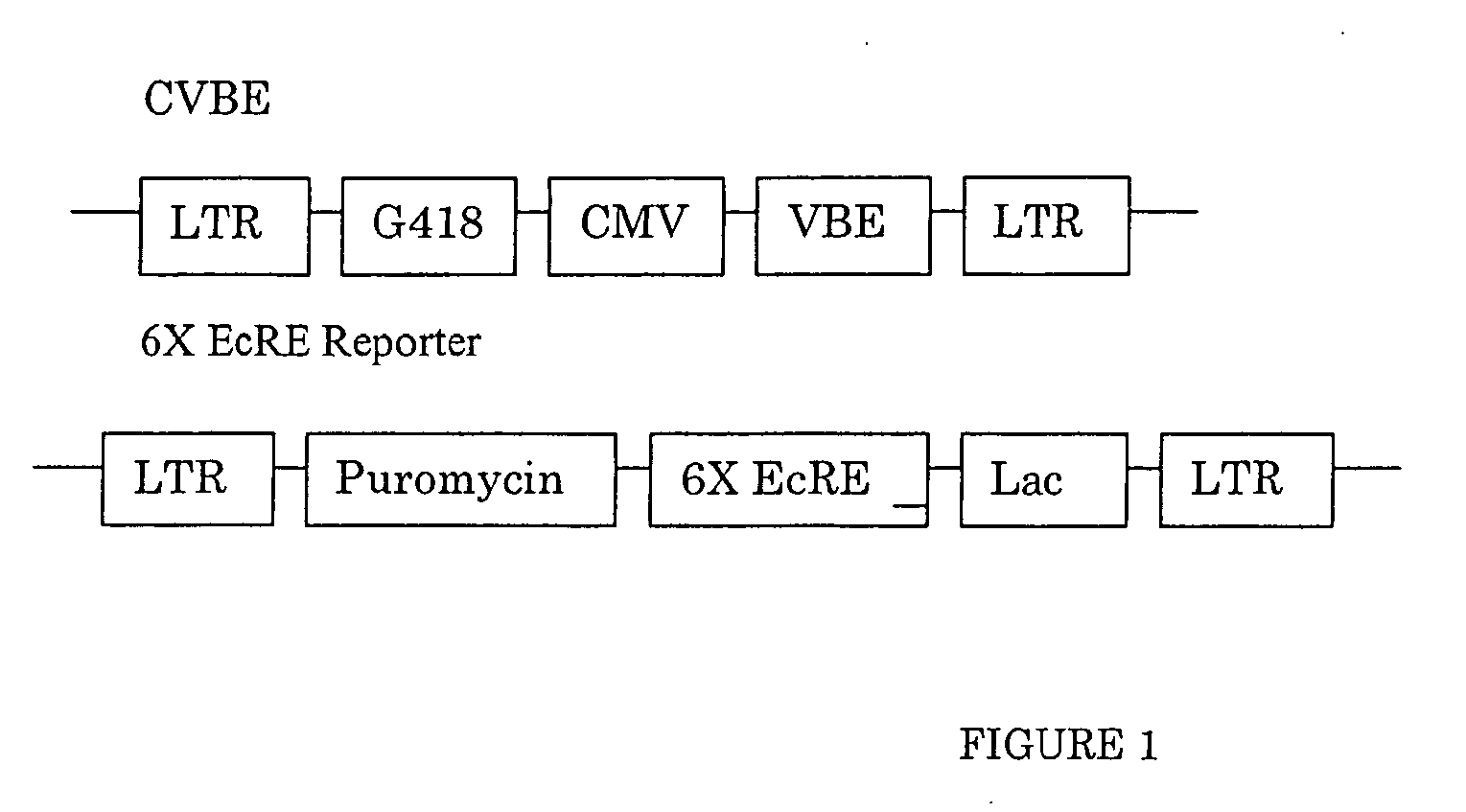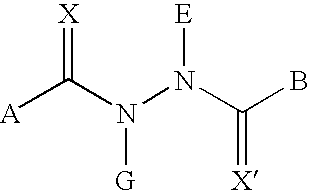Bioavailable diacylhydrazine ligands for modulating the expression of exogenous genes via an ecdysone receptor complex
a technology of ecdysone receptor and diacylhydrazine, which is applied in the field of biotechnology or genetic engineering, can solve the problems of limited use of pr1-a, system limitations, and leakage of systems
- Summary
- Abstract
- Description
- Claims
- Application Information
AI Technical Summary
Benefits of technology
Problems solved by technology
Method used
Image
Examples
example 1
Preparation of Compounds
[0263] The compounds of the present invention may be made according to the following synthesis routes.
1.1 Preparation of 3,5-Dimethyl-benzoic acid N-tert-butyl-N′-(4-ethyl-2-fluoro-benzoyl)-hydrazide (RG-101523)
[0264]
[0265] To a 3-neck, 2 L round bottom flask was added 173.71 g (1.0 mol, 97%) of 2-amino-2-methyl-1-propanol in 300 mL of dry methylene chloride. The flask was equipped with a magnetic stir bar and thermometer and was placed into a dry ice / acetone bath and cooled to 0° C. From a separatory funnel, a solution of 4-ethylbenzoyl chloride (168.5 g, 1.0 mol), dissolved in about 300 mL of methylene chloride was slowly added, while maintaining the reaction temperature below 5° C. The mixture was allowed to stir at room temperature overnight. Solid propanol amine-HCl was filtered off and the filter cake was washed with methylene chloride. The combined methylene chloride extracts were concentrated partially on a rotary evaporator and used directly in th...
example 2
Determination of Physical and Transport Properties
2.1 Determination of LC logP (experimental)
[0427] 1000 ppm solutions for each of a set of logP standards (compounds for which logP is known experimentally; see Table 3) and for each test compound are prepared. Liquid chromatography retention times (RT) are measured for each substance using the conditions described below. A linear equation is derived relating RT to logP is developed from the data for the logP standards. The logP for the test compound is calculated from the logP / retention time equation.
Chromatogaphic conditions:Column:MetaChem Polaris A-18 3 u 50 × 3.0 mm;part no C2001-050x030time (min.)methanol (%)water (%)Solvent Gradient:0.025757.09918.02575Temperature: (° C.):30Detector Type:UV or DAD (diode array detector): 200-220 nm
2.2 Determination of C logP
[0428] ClogP can be calculated according to standard calculations known to those of skill in the art. Exploring QSAR: Fundamentals and Applications in Chemistry and B...
example 3
Biological Testing of Compounds
[0449] The ligands of the present invention are useful in various applications including gene therapy, expression of proteins of interest in host cells, production of transgenic organisms, and cell-based assays.
27-63 Assay
[0450] GAL4 DBD (1-147)-C / EcR(DEF) / VP16AD-βRXREF-LmUSPEF: The wild-type D, E, and F domains from spruce budworm Cloristoneura fumiferana EcR (“CfEcR-DEF”; SEQ ID NO: 1) were fused to a GAL4 DNA binding domain (“Gal4 DBD1-147”; SEQ ID NO: 2) and placed under the control of a phosphoglycerate kinase promoter (“PGK”; SEQ ID NO: 3). Helices 1 through 8 of the EF domains from Honto sapiens RXRβ (“HsRXRβ-EF”; nucleotides 1-465 of SEQ ID NO: 4) and helices 9 through 12 of the EF domains of Locusta migratoria Ultraspiracle Protein (“LmUSP-EF”; nucleotides 403-630 of SEQ ID NO: 5) were fused to the transactivation domain from VP16 (“VP16AD”; SEQ ID NO: 6) and placed under the control of an elongation factor-1α: pr...
PUM
 Login to View More
Login to View More Abstract
Description
Claims
Application Information
 Login to View More
Login to View More - R&D
- Intellectual Property
- Life Sciences
- Materials
- Tech Scout
- Unparalleled Data Quality
- Higher Quality Content
- 60% Fewer Hallucinations
Browse by: Latest US Patents, China's latest patents, Technical Efficacy Thesaurus, Application Domain, Technology Topic, Popular Technical Reports.
© 2025 PatSnap. All rights reserved.Legal|Privacy policy|Modern Slavery Act Transparency Statement|Sitemap|About US| Contact US: help@patsnap.com



